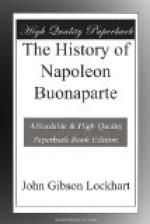The Duke of Modena would fain have redeemed the famous St. Jerome, of Correggio, at the price of L80,000; and Buonaparte’s lieutenants urged him to accept the money. “No,” said he, “the duke’s two millions of francs would soon be spent; but his Correggio will remain for ages to adorn Paris, and inspire the arts of France.” The prophecy was not inspired. Of one thing there can be no doubt; namely, that the abstraction of these precious monuments of art from the Italian collections was deeply and permanently resented by the Italian people. This sacrilege, as those enthusiastic and intelligent lovers of all the elegant arts considered it, turned back many a half-made convert from the principles of the French Revolution.
Buonaparte remained but five days in Milan; the citadel of that place still held out against him; but he left a detachment to blockade it, and proceeded himself in pursuit of Beaulieu. The Austrian had now planted the remains of his army behind the Mincio, having his left on the great and strong city of Mantua, which has been termed “the citadel of Italy,” and his right at Peschiera a Venetian fortress, of which he took possession in spite of the remonstrances of the Doge. Peschiera stands where the Mincio flows out of “its parent lake,” the Lago di Guarda. That great body of waters, stretching many miles backwards towards the Tyrolese Alps, at once extended the line of defence, and kept the communication open with Vienna. The Austrian veteran occupied one of the strongest positions that it is possible to imagine. The invader hastened once more to dislodge him.
The French Directory, meanwhile, had begun to entertain certain not unnatural suspicions as to the ultimate designs of their young general, whose success and fame had already reached so astonishing a height. They determined to check, if they could, the career of an ambition which they apprehended might outgrow their control. Buonaparte was ordered to take half his army, and lead it against the Pope and the King of Naples, and leave the other half to terminate the contest with Beaulieu, under the orders of Kellerman. But he acted on this occasion with the decision which these Directors in vain desired to emulate. He answered by resigning his command. “One half of the army of Italy,” said he, “cannot suffice to finish the matter with the Austrian. It is only by keeping my force entire that I have been able to gain so many battles and to be now in Milan. You had better have one bad general than two good ones.” The Directory durst not persist in displacing the chief whose name was considered as the pledge of victory. Napoleon resumed the undivided command, to which now, for the last time, his right had been questioned.
Another unlooked-for occurrence delayed, for a few days longer, the march upon Mantua. The heavy exactions of the French, and even more perhaps the wanton contempt with which they treated the churches and the clergy, had produced or fostered the indignation of a large part of the population throughout Lombardy. Reports of new Austrian levies being poured down the passes of the Tyrol were spread and believed. Popular insurrections against the conqueror took place in various districts: at least 30,000 were in arms. At Pavia the insurgents were entirely triumphant; they had seized the town, and compelled the French garrison to surrender.




